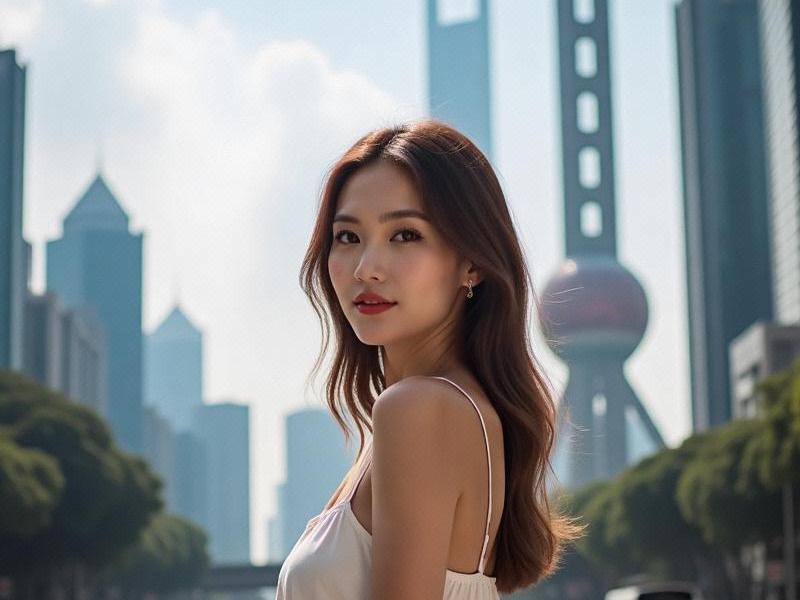This investigative feature explores how Shanghai's women are creating a unique beauty aesthetic that blends centuries-old traditions with cutting-edge innovation, setting new standards across Asia.

The morning light filtering through the plane trees of the French Concession reveals Shanghai's daily beauty ritual in motion. At sidewalk cafes, young professionals sip matcha lattes while reapplying the now-iconic "Shanghai Glow" - a dewy complexion look that has become the city's signature. In nearby salons, stylists work their magic, blending 1930s finger wave techniques with digital perm technology. This is Shanghai beauty in 2025: a fascinating alchemy of past and future.
Shanghai's beauty industry now generates $9.2 billion annually, accounting for 22% of China's premium cosmetics market. But beyond the impressive economics lies a cultural revolution. "Shanghai women have developed a beauty language that speaks both Mandarin and global dialect," observes cultural anthropologist Dr. Emma Zhao. "Their style maintains Chinese philosophical roots while embracing worldwide influences."
The contemporary Shanghai beauty regimen reveals three distinctive layers:
1. Skin First Philosophy
The city's humid climate and pollution challenges have birthed an obsessive skincare culture. Department stores report 68% of beauty spending goes to skincare, with hybrid products leading growth. The bestselling "Dragon Well Dew" serum by local brand Formulaw combines Hangzhou green tea extract with Swiss glacier water and Korean fermentation technology.
阿拉爱上海 2. The Minimalist Makeup Movement
Contrasting with Beijing's bold colors or Chengdu's playful styles, Shanghai makeup emphasizes "strategic enhancement." The look involves:
- Skin-like foundation with 24-hour humidity control
- "Bamboo Brow" technique using single hair strokes
- Gradient lips blending two shades of rose
- The signature "Pudong Pupil" eye makeup that enlarges eyes without obvious liner
3. Hair as Cultural Canvas
上海贵族宝贝自荐419 Shanghai's hair trends tell a story of cultural preservation. The Shanghai Hair Heritage Museum has identified 89 historical styles now being reinterpreted. Modern versions of 1920s "wave clouds" (波浪云) and 1940s "victory rolls" appear in financial district offices, updated with thermal protection and lighter hold products.
The business world amplifies these trends. A Morgan Stanley Shanghai survey found 91% of female executives believe personal grooming impacts career progression. However, the preferred aesthetic differs significantly from other Chinese cities - what consultants call "the Shanghai Subtraction":
- 40% less makeup than Beijing standards
- 60% less hair product than Guangzhou styles
- 75% more attention to skincare than national average
Digital native brands like Lessismore (founded by Shanghai native Mia Chen) capitalize on this, offering curated 5-product routines that promise "elevated efficiency." Their flagship store on Anfu Road features AI skin scanners that recommend personalized regimens in 90 seconds.
爱上海同城对对碰交友论坛
Cultural preservation efforts have gained momentum through initiatives like the Shanghai Beauty Archive, which has documented over 200 vintage cosmetic tools and techniques. Contemporary artists frequently collaborate with the archive, creating installations like "Rouge Memory" - an exhibition tracing lipstick evolution from crushed pearl formulations to today's lab-grown pigment technology.
The movement faces challenges, notably around inclusivity. While Shanghai's beauty standards have diversified in recent years (with more representation for single-eyelid features and darker skin tones), critics argue progress remains slow. The "My Shanghai Beauty" campaign, featuring 100 diverse local women, represents one effort to broaden definitions.
As sustainability concerns grow, Shanghai's beauty scene is responding. Waterless beauty products saw 240% growth in 2024, while refill stations now appear in 30% of Wulumuqi Road boutiques. The municipal government's "Green Beauty" initiative provides subsidies for brands developing biodegradable packaging.
What emerges is a portrait of Shanghai women rewriting beauty rules on their own terms - honoring tradition while fearlessly innovating, proving that in China's most cosmopolitan city, elegance is not about following trends, but setting them.